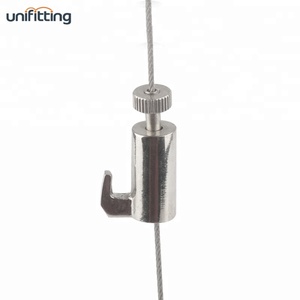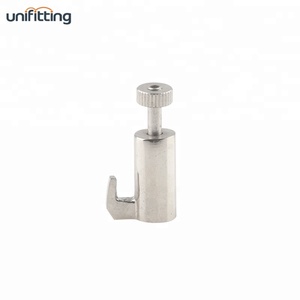(896 products available)







































































































































































Suspended ceiling hooks are devices used to attach items to a suspended ceiling. They come in different types, including the following:
Grid hooks
Grid hooks are the most common type of hook for suspended ceilings. They are L-shaped and easily slide into the T-bar of the ceiling grid. The open end of the grid hook is used to hang items such as plants, light fixtures, or decorations. Grid hooks are available in different sizes and weight capacities to accommodate various hanging needs.
J-hook
J-hooks resemble the letter J and are used in place of grid hooks. They are installed on top of the ceiling tiles and provide a sturdy hanging point. J-hooks are ideal for heavier items since they distribute the weight more evenly across the ceiling grid.
Cross-tee hooks
Cross-tee hooks are designed to fit onto the cross tees that intersect in a suspended ceiling grid. They provide a strong hanging point and are suitable for medium-weight items. Like other ceiling hooks, cross-tee hooks are available in various sizes to accommodate different ceilings.
Heavy-duty ceiling grid hooks
These hooks are specifically designed for heavier loads. They have a higher weight capacity and usually feature a reinforced construction. Heavy-duty ceiling grid hooks are ideal for hanging heavy lighting fixtures, speakers, or other equipment commonly found in commercial spaces.
Magnetic hooks
Magnetic hooks provide a no-damage solution for temporary hanging needs. They use strong magnets to attach to metal ceiling grids, making installation and removal easy. Magnetic hooks are suitable for lightweight items and are often used in exhibition spaces or classrooms where hanging needs frequently change.
Adhesive hooks
Adhesive hooks are another no-damage option for temporary hanging. They use adhesive to attach to the ceiling tile and are best for lightweight items. Adhesive hooks are convenient for temporary decorations or organizational solutions but may not be suitable for all ceiling tile surfaces.
Suspended ceiling hooks are an essential component for anyone planning to install a suspended ceiling.
They come with various features, including:
Material
Suspended ceiling hooks are made from various materials. This ensures they are durable and sturdy enough to hold the weight of the ceiling tiles and any additional fixtures. Some common materials used are stainless steel, galvanized steel, aluminum, and high-strength plastic. Steel and aluminum are preferred for their strength and lightweight properties. The suspended ceiling hooks are usually coated with materials like powder paint or galvanized to prevent rust and corrosion.
Design
The design of a suspended ceiling hook varies to accommodate different types of ceiling materials and configurations. Some commonly used designs are L-shaped, J-shaped, T-shaped, straight, and adjustable hooks. L-shaped hooks are ideal for hanging ceilings in offices, homes, and commercial buildings. J-shaped and T-shaped hooks are used when the ceiling tile has J-shaped and T-shaped edges, respectively. The straight hook is versatile and used in many applications. The adjustable hook can be easily customized to fit different height requirements and ceiling configurations.
Weight capacity
Each suspended ceiling hook has a specific weight capacity. This indicates the maximum weight it can safely support. The weight capacity varies depending on the hook material, thickness, and design. For instance, steel hooks have a higher weight capacity than those made of aluminum. It is important to choose a hook with a weight capacity that exceeds the combined weight of the ceiling tiles and any additional fixtures or objects that will be hung from the ceiling.
Ease of installation
Suspended ceiling hooks are designed to be easy to install. Most of them have pre-drilled holes for quick and easy installation using screws or rivets. Some hooks are also equipped with locking mechanisms. This ensures that once the tile is installed, it remains securely in place and prevents accidental disengagement.
Adjustability
Some types of suspended ceiling hooks are adjustable. This feature allows users to customize the length and height of the hook. This is particularly useful in situations where ceilings are at different heights or where tiles need to hang at a specific distance from the ceiling. Adjustable hooks provide flexibility during installation and ensure a precise fit.
Suspended ceiling hooks are versatile and provide solutions in various industries. Some common application scenarios include:
Construction and Building Projects
Construction companies use suspended ceiling hooks to install drop ceilings in residential, commercial, and industrial buildings. These hooks support light fixtures, air conditioning vents, and other ceiling components, making them essential in building construction.
Interior Design and Space Planning
Interior designers use suspended ceiling hooks to create aesthetically pleasing and functional ceilings. These hooks support acoustic tiles, decorative panels, and other ceiling elements that contribute to the overall design of a room.
Office Spaces and Commercial Establishments
Office managers and facility operators use suspended ceiling hooks to install and maintain office ceilings. These hooks support lighting systems, HVAC ducts, and acoustic tiles, making them essential for office functionality and comfort.
Retail Stores and Shopping Malls
Retailers and property managers use suspended ceiling hooks to install and maintain store ceilings. These hooks support lighting, signage, and other ceiling elements crucial for customers' shopping experience and store operations.
Healthcare Facilities
Healthcare providers use suspended ceiling hooks to install and maintain hospital ceilings. These hooks support lighting, HVAC systems, and acoustic tiles, essential for healthcare facilities' cleanliness, functionality, and comfort.
Educational Institutions
School administrators and maintenance staff use suspended ceiling hooks to install and maintain school ceilings. These hooks support lighting, ventilation, and soundproofing, making them essential for schools' operations and students' learning environments.
Manufacturing and Industrial Settings
Manufacturers and facility operators use suspended ceiling hooks to install and maintain factory ceilings. These hooks support lighting, ventilation, and noise reduction, making them essential for manufacturing operations and industrial settings.
Hospitality Industry
Hotel managers and restaurant operators use suspended ceiling hooks to install and maintain ceilings. These hooks support lighting, HVAC systems, and acoustic tiles, essential for hospitality facilities' operations and guests' comfort.
Event Spaces and Convention Centers
Event planners and venue operators use suspended ceiling hooks to install and maintain ceilings. These hooks support lighting, ventilation, and soundproofing, essential for events and conventions' operations and attendees' comfort.
When choosing the right kind of suspended ceiling hooks, there are several factors that should be considered. These include:
Q1: How many suspended ceiling hooks do I need?
A1: The number of hooks depends on the size of the ceiling and the tiles. Measure the ceiling and plan the grid layout to determine the quantity.
Q2: What are the load limits for suspended ceiling hooks?
A2: Load limits vary by material. Plastic hooks support lightweight tiles, while metal handles are for heavier tiles. Check specifications for details.
Q3: Are the suspended ceiling hooks easy to install?
A3: Yes, installation is straightforward. Align the grid, secure the tiles using the hooks, and place the ceiling grid above for support. Follow the provided instructions.
Q4: How do I maintain my suspended ceiling and hooks?
A4: Regularly check the grid and tiles for stability. Clean the hooks and tiles to remove dust. Replace any damaged tiles or hooks promptly to maintain ceiling integrity.
Q5: Can I use the same hooks for different tile materials?
A5: It's best to use hooks recommended for specific tile materials. Different hooks have varying load capacities and attachment methods suitable for plastic or metal tiles.